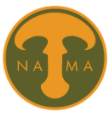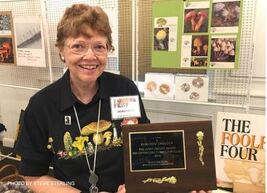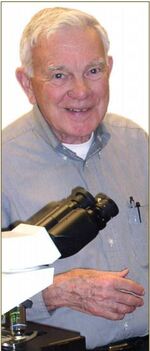Our Story
|
The New Jersey Mycological Association is a 501c(3) non-profit whose aim is to provide a way for members to share knowledge, ideas and experiences with people who want to increase their understanding of the world of fungi. Forays occur weekly during the active mushroom season, and are held in different locations around the state. Members fungal related interests include identifying fungi they find (taxonomy), learning about edible fungi, photography, cultivation, dying natural fibers with mushrooms, paper-making, botanical illustrations and jewelry making. Many of us have become friends while pursuing our passion for fungi, and we welcome beginners as well as experts. NJMA is one of the largest most active clubs in the country with over 600 members. Here is the story of how we got started.
|
|
1971
Although people have been foraging wild mushrooms for food and medicine throughout history, the New Jersey Mycological Association’s origins began over 50 years ago. In early 1971, Hiram Korm placed an advertisement in several Morris County newspapers looking for folks “who were interested in increasing their general knowledge about fungi and having fun.” The first meeting at was held at Tourne Park in Boonton, NJ on May 15. The ten people who showed up for that first foray decided to name their group The Mushroom Hunters Cub. At the second meeting in June, the group decided to change their name to the Lakeland Mycology Club to reflect that the member’s interest was “not confined to eating wild mushrooms.” Dues were set at $1.00 annually, and Hiram Korm was unanimously elected President. Ed Bosman had published the club’s first newsletter which was hand drawn and illustrated in July. By December the club boasted 28 members. |
1972
At the March meeting other club officers were elected, and a discussion ensued about limiting membership to its current 34 members to prevent overcrowding at forays. Ultimately a decision was made to ”encourage growth and accept new ideas, and the challenges commensurate with the hoped for expansion.” The first annual picnic was held at Stokes State Park, a tradition that carries on to this day, named for Grete Turchick in honor of one of our enthusiastic, early members
At the March meeting other club officers were elected, and a discussion ensued about limiting membership to its current 34 members to prevent overcrowding at forays. Ultimately a decision was made to ”encourage growth and accept new ideas, and the challenges commensurate with the hoped for expansion.” The first annual picnic was held at Stokes State Park, a tradition that carries on to this day, named for Grete Turchick in honor of one of our enthusiastic, early members
|
1973
By February, the Lakeland Mycology Club had 43 active members, and became affiliated with The North American Mycological Association, the national umbrella organization for local mushroom groups. Regular forays and meetings continued throughout the mushroom season and culminated with a pot luck Christmas Party in December, a tradition embraced by our group to this day. |
1974
July marked the club’s first lecture by a professional mycologist, Dr. Sam Ristich, an entomologist, mycologist and educator from the NY Botanical Garden who held a PhD from Cornell University. Sam’s enthusiasm and extensive knowledge of the natural world was infectious, and he became a valuable asset to amateur mycologists for over half a century. Inviting professionals to speak reflected a growing interest beyond edible fungi. Meetings began to be held at the Morris County Environmental Education Center in Chatham instead of private homes, schools or churches. Our first mycology field checklist was created that year by member, Victor Gambino.
July marked the club’s first lecture by a professional mycologist, Dr. Sam Ristich, an entomologist, mycologist and educator from the NY Botanical Garden who held a PhD from Cornell University. Sam’s enthusiasm and extensive knowledge of the natural world was infectious, and he became a valuable asset to amateur mycologists for over half a century. Inviting professionals to speak reflected a growing interest beyond edible fungi. Meetings began to be held at the Morris County Environmental Education Center in Chatham instead of private homes, schools or churches. Our first mycology field checklist was created that year by member, Victor Gambino.
1975
Reflecting the expanding geographic base and interests, the club’s name was changed to the New Jersey Mycological Association in 1975. That year with 10 forays, 2 lectures by professional mycologists and 6 meetings, the group was on its way to becoming what it is today. Dues were increased to $5.00 annually to cover mailing costs and facility rentals. Later that year member Victor Gambino reached out to Ed Bosman and his wife who had recently moved to Connecticut to see if his new club would like to get together for a 3 day weekend with forays and educational programs. NJMA continues to host the Victor Gambino Memorial Weekend every few years in the Delaware Water Gap Area.
Reflecting the expanding geographic base and interests, the club’s name was changed to the New Jersey Mycological Association in 1975. That year with 10 forays, 2 lectures by professional mycologists and 6 meetings, the group was on its way to becoming what it is today. Dues were increased to $5.00 annually to cover mailing costs and facility rentals. Later that year member Victor Gambino reached out to Ed Bosman and his wife who had recently moved to Connecticut to see if his new club would like to get together for a 3 day weekend with forays and educational programs. NJMA continues to host the Victor Gambino Memorial Weekend every few years in the Delaware Water Gap Area.
|
1977
1977 was dubbed the “Year of the Taxonomist” with Bob Peabody, Dorothy Smullen and Grete TurchIck elected to hold club offices. To increase members scientific understanding of fungi, lectures were presented by professionals such as Dr. Eugene Varney from Rutgers, Dr. Sam Ristich, Dr. Clark Richardson, Gary Lincoff from the NY Botanic Garden, and Dr. Martina Gilliam from Hood College. Members enjoyed collecting and cooking wild edibles as part of the Culinary Group, and at pot lucks throughout the year |
Bob Peabody
Dorothy Smullen
|
|
1978
In 1978 the club moved to the Somerset County Environmental Education Center (SCEEC) in Basking Ridge for its regular meetings. This location also gave a home to the clubs growing herbarium and a place for its taxonomy group to meet. By 1978 the long weekends were expanded to include multiple clubs in New England and the MidAtlantic states to form the Northeast Mycological Federation (NEMF). These weekends have been named after their founder, Dr. Sam Ristich, continue to be held annually throughout the Northeast, featuring interesting forays, identification sessions and lectures by noted mycologists. NJMA membership grew to 170. Although NJMA had participated in a number of environmental outreach events with other organizations, when Jim Richards became club president in 1979, they finally decided to host their own Fungus Fest, and it was a huge success. |
2000
By the beginning of 2000, NJMA had grown to over 300 members. Dues were increased to $10.00 individual & $15.00 family to cover expenses of our growing club. Regular forays, and educational meetings continued.
By the beginning of 2000, NJMA had grown to over 300 members. Dues were increased to $10.00 individual & $15.00 family to cover expenses of our growing club. Regular forays, and educational meetings continued.
2001
In March of this 2001, Bob Hosh and Steve Gleeson created our first website, njmyco.org. This website gave us visibility on the internet making our club more accessible to a wide variety of people. Newsletters and club events became available online.
In March of this 2001, Bob Hosh and Steve Gleeson created our first website, njmyco.org. This website gave us visibility on the internet making our club more accessible to a wide variety of people. Newsletters and club events became available online.
2002
NJMA became incorporated setting its legal structure apart from the individuals who founded the group.
NJMA became incorporated setting its legal structure apart from the individuals who founded the group.
2005
After many years at the Somerset County Environmental Center, the costs and limited parking prompted us to move our meetings to the Frelinghuysen Arboretum in Morristown. This beautiful venue which was more reasonable financially had a large meeting room and ample parking. The Holiday Party and the Mycophagy Meeting were moved to the Unitarian Society in East Brunswick because of its kitchen capacity. The NJMA Herbarium was transferred to the Chrysler Herbarium at Rutgers University. A yahoo group was created by Jim Barg to help members identify their finds, although this site has been replaced by our Facebook group.
After many years at the Somerset County Environmental Center, the costs and limited parking prompted us to move our meetings to the Frelinghuysen Arboretum in Morristown. This beautiful venue which was more reasonable financially had a large meeting room and ample parking. The Holiday Party and the Mycophagy Meeting were moved to the Unitarian Society in East Brunswick because of its kitchen capacity. The NJMA Herbarium was transferred to the Chrysler Herbarium at Rutgers University. A yahoo group was created by Jim Barg to help members identify their finds, although this site has been replaced by our Facebook group.
|
2012
Starting with the January/February 2012 issue, newsletters were changed to an online format as mailing costs had skyrocketed. Jim Barg and Jim Richards were able to create the first full color online edition with clickable links, and beautiful graphics. Our newsletter is recognized as one of the finest in the United States. In November 2012, NJMA officially became a non-profit 501c(3) organization. |
2015
Luke Smithson established the Facebook group, the New Jersey Mycological Association Discussion Group to help share mycological information, and discuss identification fungi found in our diverse state. Maricel Patino has been the administrator of this group since 2018.
Luke Smithson established the Facebook group, the New Jersey Mycological Association Discussion Group to help share mycological information, and discuss identification fungi found in our diverse state. Maricel Patino has been the administrator of this group since 2018.
2020
The COVID 19 quarantine necessitated some changes to our club activities. No longer able to meet in large groups, Nina and John Burghardt, created small group, socially distant forays so that new members could learn about fungi from experienced members in the field. Since our meeting space at the Frelinghuysen Arboretum was closed, Luke Smithson, our Education Chairperson, created Taxonomy Tuesdays, a weekly online forum where members can share their finds and get help with identification. Along with Tom Bigelow from the NYMA, Luke scheduled online Zoom presentations with notable mycologists from the US and Canada so we can continue learning about the fascinating field of mycology in our own homes.
The COVID 19 quarantine necessitated some changes to our club activities. No longer able to meet in large groups, Nina and John Burghardt, created small group, socially distant forays so that new members could learn about fungi from experienced members in the field. Since our meeting space at the Frelinghuysen Arboretum was closed, Luke Smithson, our Education Chairperson, created Taxonomy Tuesdays, a weekly online forum where members can share their finds and get help with identification. Along with Tom Bigelow from the NYMA, Luke scheduled online Zoom presentations with notable mycologists from the US and Canada so we can continue learning about the fascinating field of mycology in our own homes.
2021
The little group of 10 “pot hunters” has grown into one of the most active clubs in the country with over 600 members. NJMA remains a non-profit 501(3) organization whose aims are to provide a means of sharing ideas, experiences, knowledge and common interests regarding fungi, and to furnish educational materials to those who wish to increase their knowledge about fungi. The enthusiasm and hard work of our members is what has helped build our club. A special thank you to Dorothy Smullen, Jim Richards, Bob Hosh, Mike Rubin, Ursula Pohl, Susan Hopkins, Rhoda Roper, Jim Barg and Melanie Spock who have been active members since the early days of NJMA. A core group of volunteers continue to work behind the scenes to make our club function.
2022 and beyond
NJMA begins to gradually reintroduce indoor activities that were put on hold because of COVID. In 2022, the Victor Gambino Weekend event was brought back. This was followed in 2023 with more indoor events like Microscopy class, Fungus Fest and the NJMA Holiday Event. Club membership now continues to peak at 900+.
New members shouldn’t be hesitant to join in or volunteer because they don’t know enough or don’t know anyone. Getting involved with NJMA will help you enjoy the company of other enthusiastic mycophiles and learn about the magical world of mushrooms. Like many of us you will probably make some fun-gal and fun-guy friends along the way
*Early club history has been taken from newsletters and a members packet put together by Jim Richards and Victor Gambino in 1985.
2021
The little group of 10 “pot hunters” has grown into one of the most active clubs in the country with over 600 members. NJMA remains a non-profit 501(3) organization whose aims are to provide a means of sharing ideas, experiences, knowledge and common interests regarding fungi, and to furnish educational materials to those who wish to increase their knowledge about fungi. The enthusiasm and hard work of our members is what has helped build our club. A special thank you to Dorothy Smullen, Jim Richards, Bob Hosh, Mike Rubin, Ursula Pohl, Susan Hopkins, Rhoda Roper, Jim Barg and Melanie Spock who have been active members since the early days of NJMA. A core group of volunteers continue to work behind the scenes to make our club function.
2022 and beyond
NJMA begins to gradually reintroduce indoor activities that were put on hold because of COVID. In 2022, the Victor Gambino Weekend event was brought back. This was followed in 2023 with more indoor events like Microscopy class, Fungus Fest and the NJMA Holiday Event. Club membership now continues to peak at 900+.
New members shouldn’t be hesitant to join in or volunteer because they don’t know enough or don’t know anyone. Getting involved with NJMA will help you enjoy the company of other enthusiastic mycophiles and learn about the magical world of mushrooms. Like many of us you will probably make some fun-gal and fun-guy friends along the way
*Early club history has been taken from newsletters and a members packet put together by Jim Richards and Victor Gambino in 1985.
Last Updated 2023-12-31











